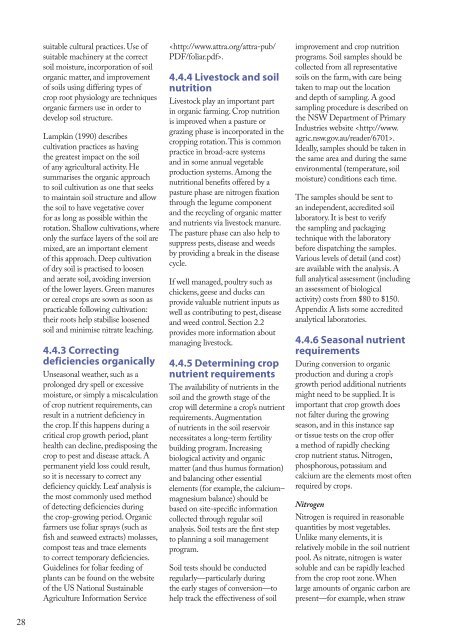4. Organic vegetable production
4. Organic vegetable production
4. Organic vegetable production
Create successful ePaper yourself
Turn your PDF publications into a flip-book with our unique Google optimized e-Paper software.
suitable cultural practices. Use of<br />
suitable machinery at the correct<br />
soil moisture, incorporation of soil<br />
organic matter, and improvement<br />
of soils using differing types of<br />
crop root physiology are techniques<br />
organic farmers use in order to<br />
develop soil structure.<br />
Lampkin (1990) describes<br />
cultivation practices as having<br />
the greatest impact on the soil<br />
of any agricultural activity. He<br />
summarises the organic approach<br />
to soil cultivation as one that seeks<br />
to maintain soil structure and allow<br />
the soil to have vegetative cover<br />
for as long as possible within the<br />
rotation. Shallow cultivations, where<br />
only the surface layers of the soil are<br />
mixed, are an important element<br />
of this approach. Deep cultivation<br />
of dry soil is practised to loosen<br />
and aerate soil, avoiding inversion<br />
of the lower layers. Green manures<br />
or cereal crops are sown as soon as<br />
practicable following cultivation:<br />
their roots help stabilise loosened<br />
soil and minimise nitrate leaching.<br />
<strong>4.</strong><strong>4.</strong>3 Correcting<br />
deficiencies organically<br />
Unseasonal weather, such as a<br />
prolonged dry spell or excessive<br />
moisture, or simply a miscalculation<br />
of crop nutrient requirements, can<br />
result in a nutrient deficiency in<br />
the crop. If this happens during a<br />
critical crop growth period, plant<br />
health can decline, predisposing the<br />
crop to pest and disease attack. A<br />
permanent yield loss could result,<br />
so it is necessary to correct any<br />
deficiency quickly. Leaf analysis is<br />
the most commonly used method<br />
of detecting deficiencies during<br />
the crop-growing period. <strong>Organic</strong><br />
farmers use foliar sprays (such as<br />
fish and seaweed extracts) molasses,<br />
compost teas and trace elements<br />
to correct temporary deficiencies.<br />
Guidelines for foliar feeding of<br />
plants can be found on the website<br />
of the US National Sustainable<br />
Agriculture Information Service<br />
.<br />
<strong>4.</strong><strong>4.</strong>4 Livestock and soil<br />
nutrition<br />
Livestock play an important part<br />
in organic farming. Crop nutrition<br />
is improved when a pasture or<br />
grazing phase is incorporated in the<br />
cropping rotation. This is common<br />
practice in broad-acre systems<br />
and in some annual <strong>vegetable</strong><br />
<strong>production</strong> systems. Among the<br />
nutritional benefits offered by a<br />
pasture phase are nitrogen fixation<br />
through the legume component<br />
and the recycling of organic matter<br />
and nutrients via livestock manure.<br />
The pasture phase can also help to<br />
suppress pests, disease and weeds<br />
by providing a break in the disease<br />
cycle.<br />
If well managed, poultry such as<br />
chickens, geese and ducks can<br />
provide valuable nutrient inputs as<br />
well as contributing to pest, disease<br />
and weed control. Section 2.2<br />
provides more information about<br />
managing livestock.<br />
<strong>4.</strong><strong>4.</strong>5 Determining crop<br />
nutrient requirements<br />
The availability of nutrients in the<br />
soil and the growth stage of the<br />
crop will determine a crop’s nutrient<br />
requirements. Augmentation<br />
of nutrients in the soil reservoir<br />
necessitates a long-term fertility<br />
building program. Increasing<br />
biological activity and organic<br />
matter (and thus humus formation)<br />
and balancing other essential<br />
elements (for example, the calcium–<br />
magnesium balance) should be<br />
based on site-specific information<br />
collected through regular soil<br />
analysis. Soil tests are the first step<br />
to planning a soil management<br />
program.<br />
Soil tests should be conducted<br />
regularly—particularly during<br />
the early stages of conversion—to<br />
help track the effectiveness of soil<br />
improvement and crop nutrition<br />
programs. Soil samples should be<br />
collected from all representative<br />
soils on the farm, with care being<br />
taken to map out the location<br />
and depth of sampling. A good<br />
sampling procedure is described on<br />
the NSW Department of Primary<br />
Industries website .<br />
Ideally, samples should be taken in<br />
the same area and during the same<br />
environmental (temperature, soil<br />
moisture) conditions each time.<br />
The samples should be sent to<br />
an independent, accredited soil<br />
laboratory. It is best to verify<br />
the sampling and packaging<br />
technique with the laboratory<br />
before dispatching the samples.<br />
Various levels of detail (and cost)<br />
are available with the analysis. A<br />
full analytical assessment (including<br />
an assessment of biological<br />
activity) costs from $80 to $150.<br />
Appendix A lists some accredited<br />
analytical laboratories.<br />
<strong>4.</strong><strong>4.</strong>6 Seasonal nutrient<br />
requirements<br />
During conversion to organic<br />
<strong>production</strong> and during a crop’s<br />
growth period additional nutrients<br />
might need to be supplied. It is<br />
important that crop growth does<br />
not falter during the growing<br />
season, and in this instance sap<br />
or tissue tests on the crop offer<br />
a method of rapidly checking<br />
crop nutrient status. Nitrogen,<br />
phosphorous, potassium and<br />
calcium are the elements most often<br />
required by crops.<br />
Nitrogen<br />
Nitrogen is required in reasonable<br />
quantities by most <strong>vegetable</strong>s.<br />
Unlike many elements, it is<br />
relatively mobile in the soil nutrient<br />
pool. As nitrate, nitrogen is water<br />
soluble and can be rapidly leached<br />
from the crop root zone. When<br />
large amounts of organic carbon are<br />
present—for example, when straw<br />
28

















